Library of Celsus That Holds History Of The Roman Era
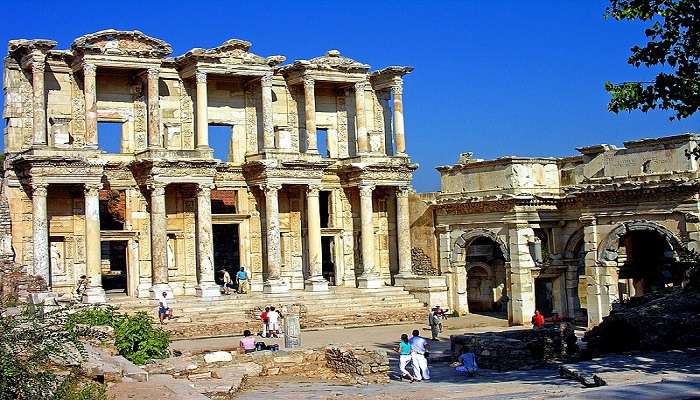
Back in the day, men in power showed off their wealth by building breathtaking palatial structures that took many years to construct. In Ephesus, Tiberius Julius Celsus Poleamaeanus’s son built a library in memory of his father called the Library of Celsus. While much of the structure was destroyed for various reasons, a part of it remains to this day, where thousands of visitors come to see the grandeur of the library, which once held over 12,000 manuscripts. The Library of Cesus is located at the heart of the city centre in Turkey. It remains an exquisite art adorning Turkey’s streets and reflecting Roman Imperial period traditions.
The Library Of Celsus: Storing Captivating Historical Facts
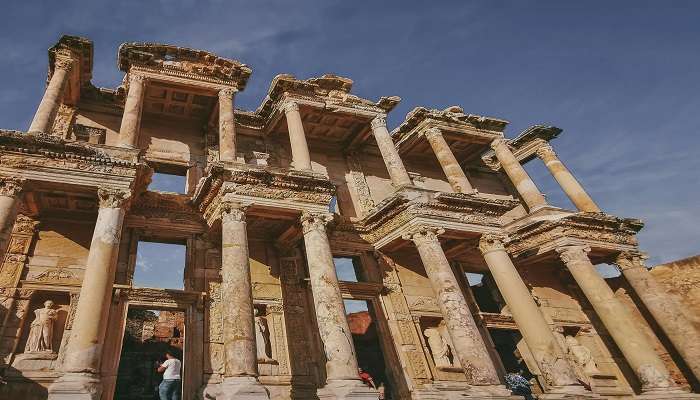
The Library of Celsus is among the most spectacular archaeological sites you will ever witness. Here is a deep dive into the facts you should know about this library, fragments of which still stand tall today.
1. The Library of Celsus was named after Tiberius Julius Celsus Polemaeanus. In the 2nd century AD, he was a Roman governor of Turkey (then known as Asia Minor).
2. It is essential to know who built the Library of Celsus. It was built by Tiberius Julius Celsus Polemaeanus’s son Julius Aquila Polemaeanus.
3. Tiberius Julius Celsus Polemaeanus gave 25,000 Denars to his son to complete construction and to use the remaining amount to purchase manuscripts for the library.
4. The construction is speculated to have begun around 110 AD and was completed by his descendants by 135 AD.
5. The library interior is around 54.8 feet by 35.8 feet.
6. The façade is 69 feet long and perched on a nine-step podium.
7. It is not just a library as Julius Celsus Polemaeanus is buried in the sarcophagus. The tomb has impressive carvings and decorations.
8. The library was ranked the third biggest, trailing behind the Alexandria Library (in Egypt) and the Pergamon Library (in Turkey).
8. all books were handwritten manuscripts on papyrus rolls during the library’s time. It is believed that around 12,000 manuscripts were kept in the library.
9. The architects tricked people by making it seem like the façade was much wider than in reality.
10. The descendants of Julius Aquila Polemaeanus completed the Library of Celsus at Ephesus. Even though he was the one who built the Library of Celsus, he died before the construction was completed.
11. The Celsus Library was destroyed twice: once by fire and then again by an earthquake. It was reconstructed, though some replicas had to be used instead of the real ones.
12. Only some people were allowed to borrow books from the Celsus Library. Otherwise, the librarian brought the books to the reading room; the only room where reading was allowed.
Must Read: Famous Landmarks In Turkey
Architecture: Definition Of Brilliance
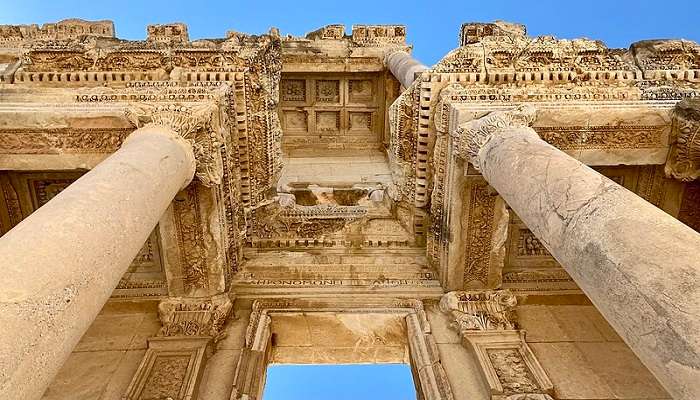
The Library of Celsus’s architecture is breathtaking today due to a mix of Greek and Roman styles. The precision with which the craftsmen worked is exemplary and showcases the beauty of the bygone era. On the one hand, the façade is constructed in Roman architectural style with magnificent carvings and lifelike status. On the other hand, you can see Greek architecture reflected in the layout of the ancient library.
The interior of it has abundant space as it is spread across 2,000 square meters. The marbled floors and the elaborate decorative motifs are a delight to the eye. The library is divided into two sections; the upper level and the lower level. The upper level contained all the books and scrolls while the lower level was where discussions, debates, and lectures happened. The lower level also had a reading room. The shelves were built in such a way as to ensure they lasted for a long time.
At first glance, you will be mesmerised by the façade, which is two-storied. On the top level, you can see the Corinthian capitals. Numerous reliefs and statues of the Library of Celsus are on the facade. Each of the statues, Sophia, Arete, Ennoia, and Episteme, represent a virtue valued at the library. Sophia symbolises wisdom, Arete represents virtue, Ennoia symbolises intelligence, and Episteme represents knowledge. The actual Library of Celsus statues is in Vienna’s Museum, and the replicas can be found in the library today.
Reconstruction

The interior portion of the ancient Library of Celsus was destroyed, severely damaging the façade. It is speculated that this was due to a fire that broke out, but no one knows how it started. In 400 AD the library became unusable due to destruction. The front part of the library was transformed into a pool. When archaeologists excavated this pool area, they found numerous reliefs that showed Parthians being defeated by Marcus Aurelius. Many of these reliefs now reside in a museum in Vienna while the remaining are in Selcuk.
The Library of Celsus reconstruction of the façade was conducted from 1970 to 1978. Volker Michael Strocka, a German archaeologist, led it. The ancient library of Celsus’s reconstruction was completed using the fragments found at archaeologists’ excavations in the early 20th century. As not all original fragments were available due to their purchase by Istanbul and Vienna museums, copies of those fragments were used instead. The Museum of Art History in Vienna has pieces from the ancient library of Celsus, while the other fragments and their copies can be found in Selcuk, in the Ephesus Museum.
Suggested Read: Place To Visit In Turkey With Family
Library Of Celsus Location, Timings, And Tickets
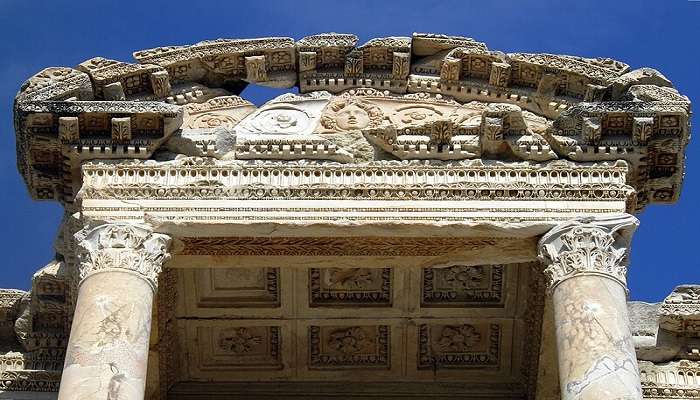
Location: The Library of Celsus is in the western region of Turkey, in Selcuk town, part of the Izmir Province.
Timings: 8 am to 12 am (the ticket window closes at 11:30 pm), Monday to Sunday (Hours may differ on specific occasions)
Tickets: INR 3,632 per person
You can purchase the tickets for the Library of Celsus online. You can also purchase tickets for the Ephesus Museum at INR 910 per person. The time of the Ephesus Museum is 8 am to 9 pm, and the ticket window closes at 8:30 pm. Both the Library of Celsus and Ephesus Museum have audio guidance that will help you understand the intricacies of the monument and the deeper meaning behind its rich history.
How To Reach Celsus Library?
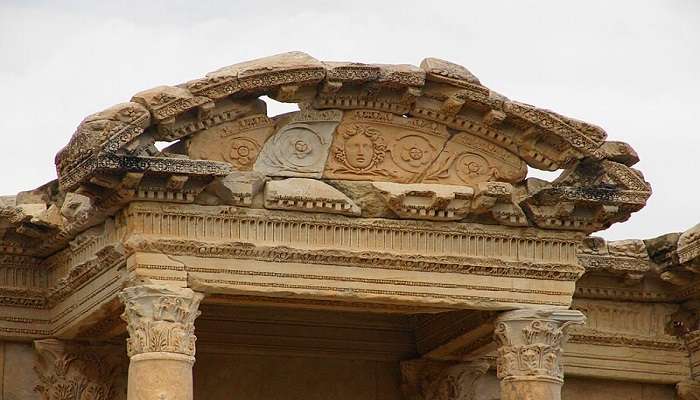
Turkey has 53 airports and the nearest airport to the Library of Celsus is the Izmir Adnan Menderes Airport. The airport is located 66.1 km from the library. You can hire a cab from the airport to get to the library. If you want to go at your own pace, you can also rent a car for your convenience.
Further Read: Churches In Turkey
The Library of Celsus is among Turkey’s most beautiful and historically significant monuments today. When you book your trip to Turkey add this to your itinerary because it will be an excellent history teacher! Learn about the splendid past now and revel in the impressive library in all its glory.
For our editorial codes of conduct and copyright disclaimer, please click here.
Cover Image Source: Wikimedia
Frequently Asked Questions About Library Of Celsus
What country is Ephesus in today?
It was a Greek city earlier, but it is now in Turkey.
Is it possible for visitors to see the tomb in the Library of Celsus at Ephesus?
No, visitors are not allowed to see the tomb at the Celsus Library.
When is the best time to visit the Celsus Library?
It is open throughout the year but the best time is early morning after it opens to beat the tourist crowd that assembles as the hours pass.
How many statues are in the library?
Apart from the four female statues near the façade, it is believed that other statues graced the walls of the library. Many of these were either on the outside of the library, tucked in niches, or inside the library itself.
Which museums are close to the Census Library?
When visiting Turkey, you can visit the following museums; Basilica of St. John, Ayasuluk archaeological site, Ephesus archaeological site of the terrace houses, and Ephesus archaeological site.
People Also Read:
Theme Parks In Turkey Historical Places In Turkey Villages In Turkey

Get ready to wander the world through amazing visual tours that we provide via our blogs and stories. As a content writer, I love sharing incredible travel experiences that inspire readers to plan their own adventures and create unforgettable memories. From planning to execution, everything has already been served in these amusing tales. Let’s explore the world together, one destination at a time!











